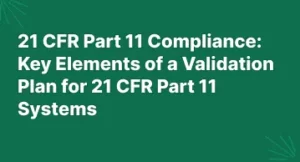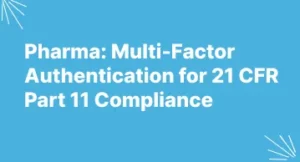Introduction: What are 21 CFR Part 820 and ISO 13485?
The 21 CFR Part 820 is a quality system regulation (QSR) issued by the United States Food and Drug Administration (FDA) which governs the design, manufacture and distribution of medical devices in the US. ISO 13485 is an international standard established by the International Organization for Standardization (ISO) for Quality Management Systems for Medical Devices.
These two regulations have been developed to improve the safety and efficacy of medical devices as they progress from development to commercialization. While both regulations share similarities, there are also significant differences. The purpose of this guide is to explain the similarities and differences between 21 CFR Part 820 and ISO 13485, and provide recommendations for choosing between them.
Overview of similarities between 21 CFR Part 820 and ISO 13485 (200 words)
21 CFR Part 820 and ISO 13485 are both standards for Quality Management Systems. Both of these management systems strive to ensure the delivery of safe, compliance-certified medical products that meet quality specifications and customer expectations, and adhere to all regulatory requirements.
In terms of similarities, 21 CFR Part 820 and ISO 13485 both require organizations to establish a Quality Management System (QMS) that outlines their processes, structure, and duties. They also mandate that organizations document their processes and review them on a regular basis. Documentation of the QMS should include details on how the organization will handle Corrective and Preventive Actions (CAPAs).
Additionally, both standards emphasize top management involvement in the development and implementation of the Quality Management System. Top management must demonstrate an active commitment to the QMS and ensure that employees at all levels of the organization are aware of all policies and procedures.
Both standards also control risk-based decision making within the system. This includes risk analysis, quality audits, and other approaches to evaluate the process. The use of risk-based thinking is encouraged throughout the QMS to ensure that decisions are made with the best interests of the customer in mind.
The similarities between 21 CFR Part 820 and ISO 13485 show that while these standards have different approaches to quality management, they both work to ensure the safety and effectiveness of medical products.
Quality System Regulation (QSR) under 21 CFR Part 820
The Quality System Regulation (QSR) is a set of requirements for the design and manufacturing of medical devices, stated in Title 21 of the Code of Federal Regulations (21 CFR). They were implemented by the United States Food & Drug Administration (FDA) to assure the safety and efficacy of medical devices. This regulation is commonly referred to as 21 CFR Part 820.
Part 820 focuses on the quality system of the manufacturer or supplier of medical devices, which includes record keeping, personnel qualifications, production processes, and product control procedures. QSR establishes certain requirements specific to the design and manufacture of medical devices, such as maintenance of records, corrective and preventive actions, complaint handling and product acceptance/rejection criteria.
All applicable manufacturers and distributors of medical devices must be compliant with 21 CFR Part 820. Compliance with QSR is enforced through inspections by FDA agents and requires device manufacturers to have a quality assurance program that meets certain specific standards.
ISO 13485 Focus on Risk-Based Product Quality
ISO 13485 is an international quality management system (QMS) designed to provide a framework to produce medical equipment that is safe for use in the public. The ISO 13485 standard focuses on risk-based product quality, meaning it ensures that all products produced meet not just the design specifications, but also be free from any potential dangers that could cause harm or damage. Quality control and prevention of mistakes are emphasized in ISO 13485.
The ISO 13485 standard is a voluntary document, meaning that companies do not have to comply with it in order to sell their products. However, many medical device manufacturers choose to do so, as they want to ensure the highest levels of safety for their products. It is also important to note that some countries may require compliance with ISO 13485 when selling medical devices.
ISO 13485 focuses on three key elements that must be met in order for a medical device to be considered safe for use in the public. These elements include: design controls, purchasing controls, and production processes. Each of these elements must be documented and monitored to ensure that they are consistently meeting the required standards.
Design controls are used to ensure that the design of the product meets the required specifications. Purchasing controls are used to check that materials and components used in the product are of the highest quality and meet the requirements of the design. Finally, production processes are used to ensure that the manufacturing process is following the requirements of the design and that the product is being produced safely and consistently.
Comparison of the Quality Management Systems under 21 CFR Part 820 and ISO 13485
The US Food and Drug Administration (FDA) uses the Quality System Regulation (QSR) under 21 CFR Part 820 to determine whether or not medical devices meet required standards. This is the same regulation that must be followed by device manufacturers that are subject to FDA jurisdiction. In addition, the International Organization for Standardization (ISO) has developed the ISO 13485 standard to guide medical device manufacturers in meeting quality management system requirements.
Both 21 CFR Part 820 and ISO 13485 establish quality management requirements for medical device manufacturers. However, there are some important differences between the two standards. 21 CFR Part 820 focuses on verifying a company’s ability to consistently produce products that meet quality standards, while ISO 13485 emphasizes ways to proactively reduce risk associated with product quality.
- Under 21 CFR Part 820, manufacturers must demonstrate control of their processes and quality assurance procedures, including validating the design of their products and establishing and following production procedures.
- ISO 13485 places more emphasis on risk management and requires manufacturers to take an active role in understanding and mitigating risks. Manufacturers must also develop and implement measures for monitoring the quality of their products.
21 CFR Part 820 and ISO 13485 both require documentation of design inputs and verification and validation activities, but there are some key differences in specific elements. 21 CFR Part 820 establishes design controls, purchasing controls, and production practices, while ISO 13485 covers requirements related to supplier quality agreements and quality records.
Differences in Design Controls, Purchasing Controls and Production Practices
While both 21 CFR Part 820 and ISO 13485 are quality management system standards, they have significant differences in the underlying details. 21 CFR Part 820 has much more detailed requirements for design controls, purchasing controls, and production practices.
For design controls, 21 CFR Part 820 requires that organizations have a formal design process, including safety evaluations, risk assessments, and design verification and validation. There must also be documented requirements for the design, and design reviews. In contrast, ISO 13485 does not specify the same level of detail for design controls, instead focusing on the need for continual improvement throughout the product lifecycle.
21 CFR Part 820 also requires specific controls over purchasing decisions. Organizations must have documented criteria for accepting vendors, conduct audits of vendors and suppliers and ensure that components and materials from those vendors meet specifications. This is stricter than the requirements of ISO 13485, which merely state that purchasing processes should be efficient and effective.
The requirements around production practices also differ between 21 CFR Part 820 and ISO 13485. 21 CFR Part 820 calls for detailed documentation regarding production processes, such as sterilization cycles, qualification of equipment, and processes for product testing and evaluation. ISO 13485 has less stringent requirements in this area, instead emphasizing the need for continual improvement and consistency in production processes.
Difference in Supplier Quality Agreements and Quality Records
21 CFR Part 820 and ISO 13485 place different requirements on supplier quality agreements and quality records. 21 CFR Part 820 requires that manufacturers establish a supplier quality agreement, whereas this is not mandatory under ISO 13485. Under 21 CFR Part 820, certain quality record must be established and maintained for at least two years. These records include inspection and test results, instrument calibration records, manufacturing records and device history records. On the other hand, ISO 13485 only requires that certain quality records be established and maintained as appropriate.
In addition, 21 CFR Part 820 specifies that all the quality records must be traceable and clear. All these records should be kept in an accessible location for the duration of time required and should be readily available for review by the FDA. ISO 13485 does not specify that the records must be traceable, or stored in an accessible location.
Regulatory Requirements for 21 CFR Part 820 and ISO 13485
It is important to understand the various regulatory requirements for 21 CFR Part 820 and ISO 13485, when considering which standard to adopt. 21 CFR Part 820 is a set of regulations established in the United States by the Food and Drug Administration (FDA) governing the design, production, packaging, labeling, testing, storage, and distribution of medical devices. On the other hand, ISO 13485 is catered more towards medical device manufacturers that are operating outside of the US and focuses on the quality management system risk management principles.
The FDA requires medical device companies to adhere to the Quality System Regulation (QSR) outlined under 21 CFR Part 820. This includes modifications to existing products as well as designing, developing and manufacturing new products. It also requires ongoing monitoring, corrective action, and preventive action in order to maintain product quality.
ISO 13485 relies heavily on risk management principles, which is a process that evaluates potential risks associated with the medical device design and development process. This allows companies to identify, analyze, and manage risk throughout the entire product life cycle. Furthermore, this standard makes recommendations regarding changes or updates to the product design.
Cost Considerations Compared to Benefits
When considering 21 CFR Part 820 and ISO 13485, it’s important to weigh up the cost implications against the potential benefits. The main cost associated with following either standard is the time needed to develop and maintain the Quality Management Systems (QMS). Both 21 CFR Part 820 and ISO 13485 require organizations to set up a system for monitoring and reviewing their compliance with safety standards.
The cost of implementing either standard will also depend on the size and complexity of the organization. Large organizations may need more resources to ensure they are meeting all the requirements. Smaller organizations may require fewer resources, but still need to be prepared to invest in a good QMS.
The benefit of following either standard is that organizations can gain market access with regulatory bodies, as well as build their reputation by showing customers, suppliers and other interested parties that they are committed to quality. Following either 21 CFR Part 820 or ISO 13485 demonstrates an organization’s ability to deliver high-quality products and services, which can help them stand out from competitors and secure customer trust.
Overall, while there is a cost associated with implementing either 21 CFR Part 820 or ISO 13485, organizations should consider the potential long-term benefits when making a decision.
Recommendations on Choosing Between 21 CFR Part 820 and ISO 13485
When making the decision between 21 CFR Part 820 and ISO 13485, there are several factors to consider. As a general rule of thumb, if you’re a US-based manufacturer, 21 CFR Part 820 is likely the right choice for greater regulatory compliance. However, it’s important to weigh the cost and benefit factors for each type of quality management system based on your particular needs. Here are some key points to consider when choosing between these two systems:
- Cost – The cost of certification under 21 CFR Part 820 may be higher than ISO 13485 due to its focus on quality assurance. However, the long-term cost savings of increased efficiency and customer satisfaction may well outweigh this initial expenditure.
- Benefits – 21 CFR Part 820 is designed with a more rigorous set of standards that has been proven to increase product reliability and safety. ISO 13485 focuses more on reducing risk-based product defects. Depending on the type of product or service you are providing, one system may offer more benefit than the other.
- Quality System Regulations – 21 CFR Part 820 focuses heavily on quality system regulations, while ISO 13485 is primarily concerned with the implementation and management of a risk-based product quality assurance system.
- Design Controls – 21 CFR Part 820 and ISO 13485 have different requirements for design control. The former has stricter requirements for design verification and validation, while the latter emphasizes risk-based product design.
- Purchasing Controls – Purchasing controls under 21 CFR Part 820 are more strict than those set forth by ISO 13485. The former requires inspections of incoming products and has stricter requirements for supplier quality agreements.
- Production Practices – 21 CFR Part 820 places an emphasis on production and process control while ISO 13485 focuses on preventive action plans for risk management.
- Quality Records – Quality records for 21 CFR Part 820 are more comprehensive compared to those for ISO 13485. The former requires detailed documentation on all aspects of product manufacturing, while the latter requires recordkeeping related to risk management.
- Regulatory Requirements – 21 CFR Part 820 is regulated by the U.S. Food and Drug Administration, while ISO 13485 is regulated by the International Organization for Standardization.
These are only a few of the considerations to make when choosing between 21 CFR Part 820 and ISO 13485. Ultimately, it’s important to weigh the costs and benefits, as well as aligning to any applicable regulatory requirements, when deciding which system is best for your product or service.
Q&A about Differences Between 21 CFR Part 820 and ISO 13485
We understand that the differences between 21 CFR Part 820 and ISO 13485 can be confusing, so we have compiled a list of commonly asked questions and answers to help explain the differences.
- What is the main difference between 21 CFR Part 820 and ISO 13485?
The main difference between 21 CFR Part 820 and ISO 13485 is the scope; 21 CFR Part 820 applies to the manufacture of medical devices, while ISO 13485 has a much broader focus on the complete product lifecycle and risk management. - What are the differences in Quality Management Systems (QMS) requirements?
21 CFR Part 820 has specific requirements for design control, production and process controls, and purchasing controls. ISO 13485 has broader requirements for quality objectives, preventive action, corrective action and risk management. - Are there differences in supplier quality agreements?
Yes, 21 CFR Part 820 requires that supplier quality agreements include specific provisions such as special processes, verification of conforming, and traceability of components. ISO 13485 does not require these specific provisions but does require that suppliers comply with applicable requirements.
Conclusion: Key Takeaway Points
When considering which regulated quality management system to use, it is important to weigh the cost and benefits of 21 CFR Part 820 and ISO 13485. Both have their advantages when it comes to reaching requirements for medical device quality management systems, but each have unique focus areas that should be considered carefully. 21 CFR Part 820 focuses on Quality System Regulation (QSR), while ISO 13485 emphasizes risk-based product quality.
In terms of design controls, purchasing controls, production practices, supplier quality agreements, and quality records, the two standards share many similarities. However, there are several distinct differences between the two that can be beneficial or limit the efficacy of one depending on the products/devices manufactured.
In summary, understanding the major differences between 21 CFR Part 820 and ISO 13485 helps you make the right decision for your specific business needs. Regulatory requirements vary depending on the product type, geographical region, and company size. Use the information presented to evaluate whether 21 CFR Part 820 or ISO 13485 is a better fit for your business.
Questions & Answers
1. What is 21 CFR Part 820?
21 CFR Part 820 is a Quality System Regulation (QSR) issued by the US Food and Drug Administration (FDA), and it specifies the requirements for a quality system covering the design and manufacture of medical devices in the United States.
2. What is ISO 13485?
ISO 13485 is an international standard that provides requirements for a quality management system for organizations involved in the design and production of medical devices.
3. What are the similarities between 21 CFR Part 820 and ISO 13485?
Both standards provide requirements and guidance for the design, development, manufacture, storage, installation, and servicing of medical devices. They also focus on quality management systems and risk-based product quality.
4. What are the differences between 21 CFR Part 820 and ISO 13485?
The QSR under 21 CFR Part 820 is more specific when it comes to product and supplier quality agreements, design controls, purchasing controls, production practices, and quality records. In addition, ISO 13485 has requirements built with a focus on proactive product and process quality planning by assessing risks.
5. What are the regulatory requirements for 21 CFR Part 820 and ISO 13485?
21 CFR Part 820 requires manufacturers to adhere to certain requirements related to product design, manufacturing, quality control, servicing, and distribution of medical devices. ISO 13485 provides a framework for developing a quality management system to satisfy applicable safety and performance requirements for their products.
6. What are the cost considerations compared to benefits when considering 21 CFR Part 820 and ISO 13485?
The cost of implementing either 21 CFR Part 820 or ISO 13485 will depend on the business, but the benefits include improved product quality, increased customer satisfaction, and better compliance with applicable regulations.
7. What is the recommended approach when deciding between 21 CFR Part 820 and ISO 13485?
Organizations should consider the following factors when deciding between the two standards: applicable regulatory requirements; cost implications; resources available for implementation; and the desired outcome.





